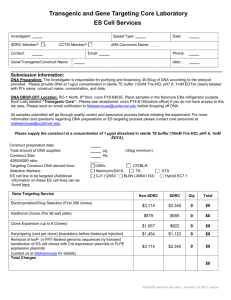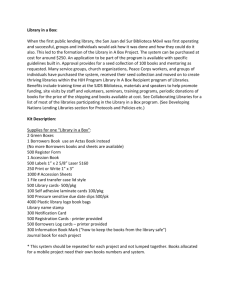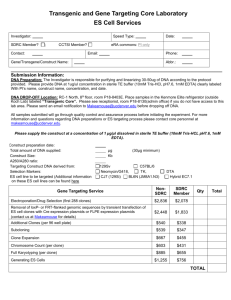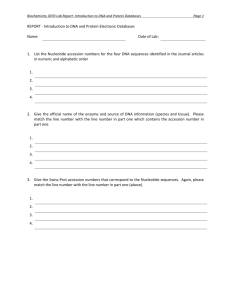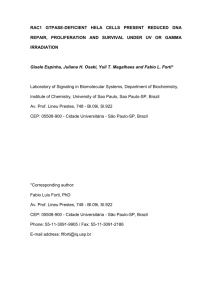library
advertisement
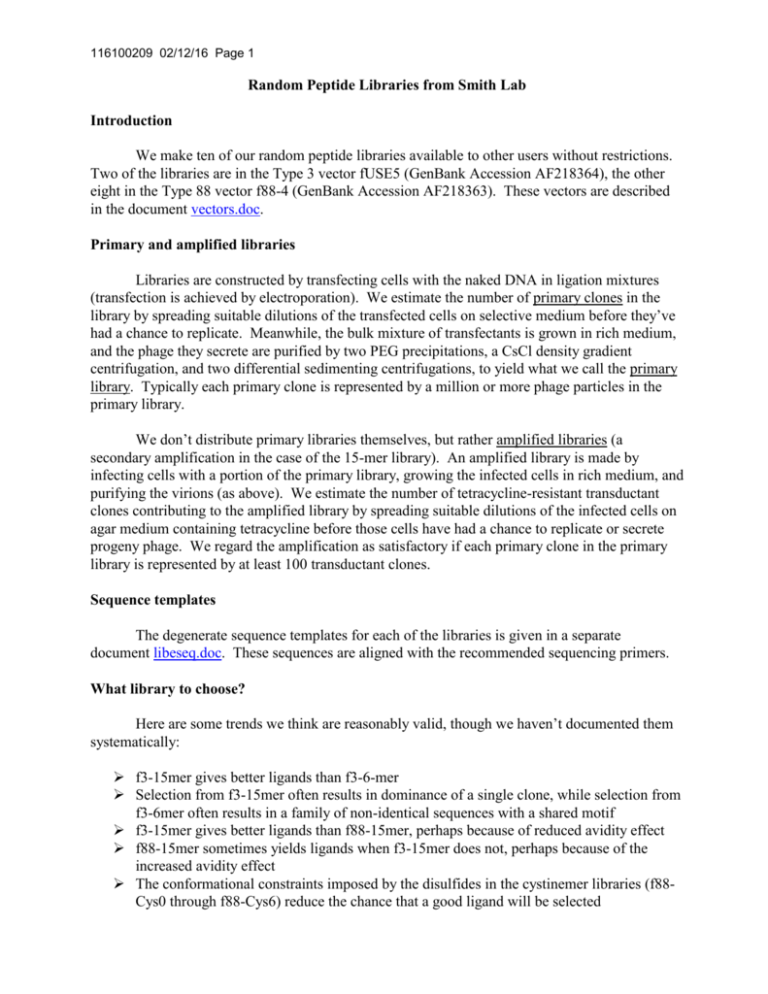
116100209 02/12/16 Page 1 Random Peptide Libraries from Smith Lab Introduction We make ten of our random peptide libraries available to other users without restrictions. Two of the libraries are in the Type 3 vector fUSE5 (GenBank Accession AF218364), the other eight in the Type 88 vector f88-4 (GenBank Accession AF218363). These vectors are described in the document vectors.doc. Primary and amplified libraries Libraries are constructed by transfecting cells with the naked DNA in ligation mixtures (transfection is achieved by electroporation). We estimate the number of primary clones in the library by spreading suitable dilutions of the transfected cells on selective medium before they’ve had a chance to replicate. Meanwhile, the bulk mixture of transfectants is grown in rich medium, and the phage they secrete are purified by two PEG precipitations, a CsCl density gradient centrifugation, and two differential sedimenting centrifugations, to yield what we call the primary library. Typically each primary clone is represented by a million or more phage particles in the primary library. We don’t distribute primary libraries themselves, but rather amplified libraries (a secondary amplification in the case of the 15-mer library). An amplified library is made by infecting cells with a portion of the primary library, growing the infected cells in rich medium, and purifying the virions (as above). We estimate the number of tetracycline-resistant transductant clones contributing to the amplified library by spreading suitable dilutions of the infected cells on agar medium containing tetracycline before those cells have had a chance to replicate or secrete progeny phage. We regard the amplification as satisfactory if each primary clone in the primary library is represented by at least 100 transductant clones. Sequence templates The degenerate sequence templates for each of the libraries is given in a separate document libeseq.doc. These sequences are aligned with the recommended sequencing primers. What library to choose? Here are some trends we think are reasonably valid, though we haven’t documented them systematically: f3-15mer gives better ligands than f3-6-mer Selection from f3-15mer often results in dominance of a single clone, while selection from f3-6mer often results in a family of non-identical sequences with a shared motif f3-15mer gives better ligands than f88-15mer, perhaps because of reduced avidity effect f88-15mer sometimes yields ligands when f3-15mer does not, perhaps because of the increased avidity effect The conformational constraints imposed by the disulfides in the cystinemer libraries (f88Cys0 through f88-Cys6) reduce the chance that a good ligand will be selected 116100209 02/12/16 Page 2 The conformational constraint imposed by the disulfide in a cystinemer library (f88-Cys0 through f88-Cys6) occasionally increases the affinity of the best selected ligand The Cys6 library frequently yields ligands with slightly improved affinity compared to the f88/15mer library; perhaps this is because the conformational constraint imposed by disulfide bonding between such distant cysteines is very weak, increasing the probability of a good ligand. In light of these trends, we recommend f3-15mer as the “default” library for most applications where the aim is to discover a single high-affinity ligand. Libraries in the Type 3 Vector fUSE5 Library f3-6mer (aka fUSE/6mer; GenBank Accession AF246446) Primary library: Scott & Smith, Science 249, 386-390, 1990 This is a secondary amplification (an amplification of an amplification) Vector: fUSE5 (foreign 6-mer displayed on all 5 copies of pIII) Number of primary clones: 2 × 108 Size of phage DNA: 9225 bases Library f3-15mer (aka fUSE/15mer; GenBank Accession AF246445) Primary library: T. Nishi, R.J.A. Budde, J.S. McMurray, N.U. Obeyesekere, N. Safdar, V.A. Levin and H. Saya, Tight-binding inhibitory sequences against pp60c-src identified using a random 15-amino-acid peptide library. FEBS Letters 399, 237–240 (1996) This is a secondary amplification (an amplification of an amplification) Vector: fUSE5 (foreign 15-mer displayed on all 5 copies of pIII) Number of primary clones: 2.5 × 108 Size of phage DNA: 9252 bases Libraries in the Type 88 Vector f88-4 (recombinant gene VIII encoding the peptide is inducible with 1 mM IPTG) Library f88-15mer (aka f88/15mer; GenBank Accession AF246448) Primary library: Sam Choukri (Smith lab) Vector: f88-4 (foreign 15-mer displayed on up to ~300 copies of pVIII) Number of primary clones: 2 × 109 Size of phage DNA: 9273 bases NOTE: The Cys0-Cys6 “cystinemer” libraries are not necessarily as stated. In particular, we think the Cys2 library is corrupted, since we don’t get clones with the intended structure. 116100209 02/12/16 Page 3 Library f88-Cys0 (aka Cys0; GenBank Accession AF246449) Primary library: George Smith Vector: f88-4 Number of primary clones: 5.6 × 108 Size of DNA: 9267 bases Library f88-Cys1 (aka Cys1; GenBank Accession AF246450) Primary library: George Smith Vector: f88-4 Number of primary clones: 2.8 × 109 Size of DNA: 9270 bases Library f88-Cys2 (aka Cys2; GenBank Accession AF246451) Primary library: George Smith Vector: f88-4 Number of primary clones: 5.5 × 107 Size of DNA: 9273 bases Library f88-Cys3 (aka Cys3; GenBank Accession AF246452) Primary library: George Smith Vector: f88-4 Number of primary clones: 5.2 × 107 Size of DNA: 9273 bases Library f88-Cys4 (aka Cys4; GenBank Accession AF246453) Primary library: George Smith Vector: f88-4 Number of primary clones: 1.7 × 108 Size of DNA: 9273 bases Library f88-Cys5 (GenBank Accession AF246454) Primary library: George Smith Vector: f88-4 Number of primary clones: 5.9 × 108 Size of DNA: 9276 bases 116100209 02/12/16 Page 4 Library f88-Cys6 (GenBank Accession AF246455) Primary library: George Smith Vector: f88-4 Number of primary clones: 2.7 × 108 Size of DNA: 9279 bases
